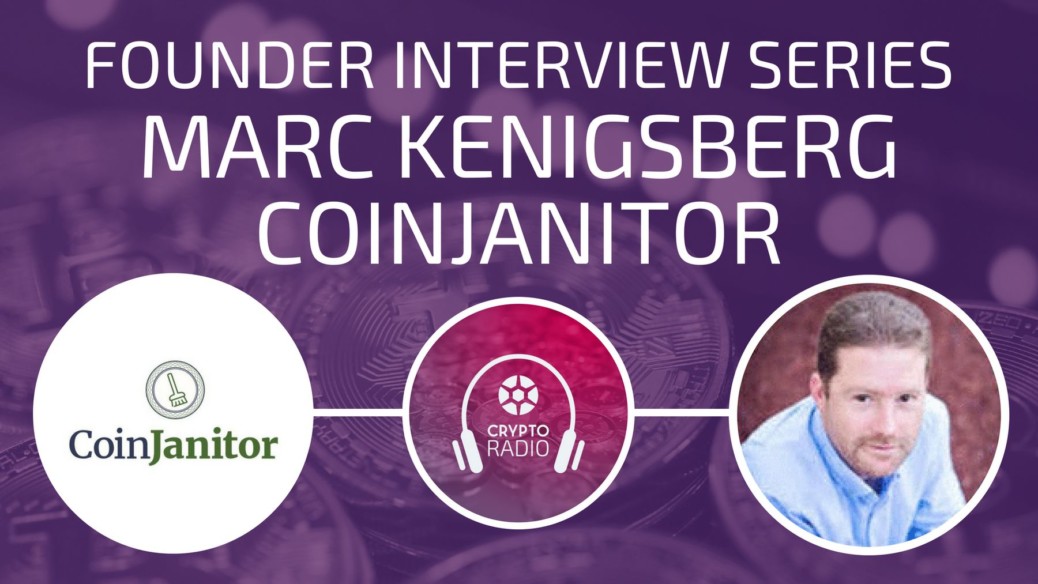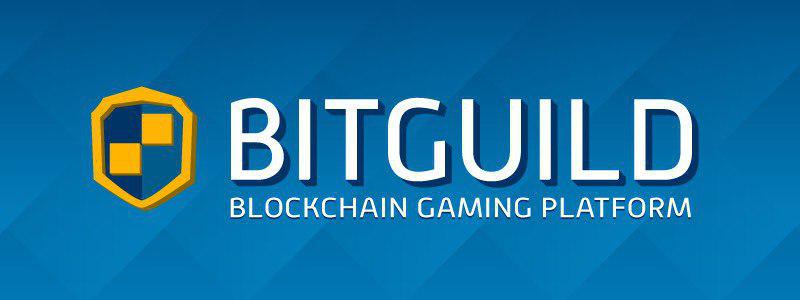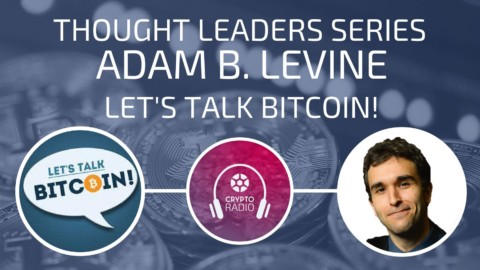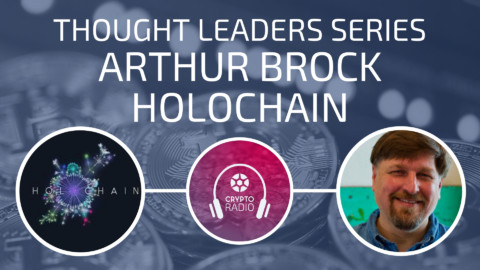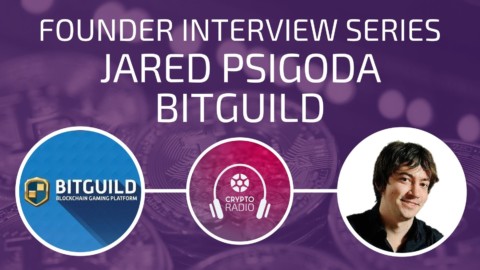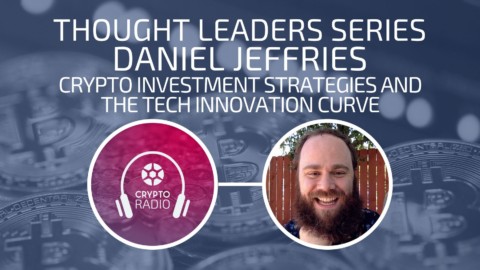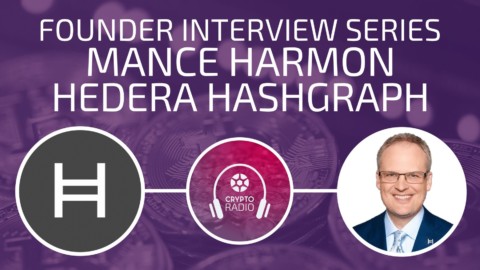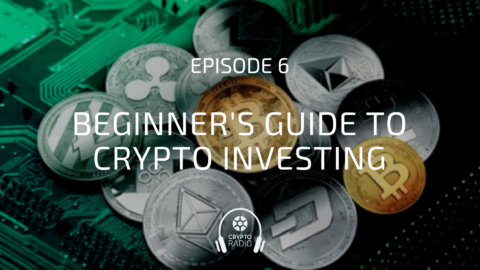Podcast: Play in new window | Download
Euvie: Hi crypto world, I’m Euvie Ivanova. Welcome back to the founder’s series. Our guest today is Mark Kenigsberg, the founder and CEO of CoinJanitor. CoinJanitor is a project that sweeps up inactive coins and pays users to trade them in. It also monitors the health of the different projects in the crypto space and provides APIs for this data to be used on other platforms. CoinJanitor is now in the middle of their public sale, which ends on May 31st, 2018. Cosyndicate is [00:00:30] announcing a partnership with CoinJanitor to share and monitor data on the health of the projects that come through the Cosyndicate investing platform.
This will enable Cosyndicate users to see how well the projects they invested in are doing over time. For all the links and show notes from this episode, go to cryptoradio.io/ coinjanitor. This episode was brought to you by bitguild.io. Bitguild is a new gaming platform built using blockchain technology. Their mission is to redefine the relationship between [00:01:00] gamers and game developers. On the Bitguild platform gamers maintain full ownership and control of their virtual items, which are stored on the blockchain. They can transfer items and progress between compatible games and they can make in game transactions safely and cheaply, and sometimes free.
Developers who join the platform will get a direct link to an established player base, a strong community, and a network of like-minded developers building on the same platform. Developers will also have the potential for direct game development funding from Bitguild. The first version of the Bitguild [00:01:30] portal is now live. You can login with Meta Mask, but the Plat token, and play Bitguild’s first game, Ether Online. They now have a full inventory wallet system for in game items. In the coming weeks, the marketplace will be implemented and several independent developers are joining the site to bring their unique games to the Bitguild family. Go to cryptoradio.io/play to start playing and join the Bitguild official Discord server to connect with the team.
Mike: Welcome to Crypto Radio. [00:02:00] We interview the top thinkers and entrepreneurs in the blockchain and cryptocurrency industry. We also cover topics like trading, investing, and ICOs. We’re your hosts Mike Gilliland, Michael Paul, Chris Sparks, and Euvie Ivanova. We’re entrepreneurs, crypto investors, and co-founders of a new blockchain investment platform called cosyndicate.io. We created Cosyndicate and Crypto Radio to make crypto investing a better experience for you. If you’re new to the show and you’d like a list of our top episodes and resources, go to cryptoradio.io/start.
[00:02:30] If you like our podcast, you can subscribe, share, and follow us on social media and leave us a rating and review on iTunes and elsewhere. It helps others find the show and we really appreciate it. You can find all those links at cryptoradio.io/start.
Euvie: Hi Mark, welcome to the show.
Mark: Hi Euvie, thanks for having me.
Euvie: Why don’t you hit us with your elevator pitch?
Mark: It’s very simple. The product we’re talking about is CoinJanitor. The idea of CoinJanitor is to try clean up the [00:03:00] too many failed coins and dead coins in the market, so we can have a healthier marketplace and restore some of the lost value from these projects.
Euvie: How do you do that?
Mark: We cooperate with project owners, we take over these projects and we buy out all of the tokens by paying users for all of their coins that they hold that aren’t worth anything anymore. Then we strip out all of the assets from the project, anything that’s reusable in terms of websites or code, [00:03:30] then we shut down the blockchain and delete the cryptocurrency.
Euvie: Interesting. How did you come up with this idea?
Mark: I was having an argument with a friend about the number of worthless coins that exist in crypto and the idea that, at some point in the future, it’s going to come back to bite us unless we do something about it. We realized that there was actually no record, there was no place you could go to check how many coins there were or the health of these projects. We started [00:04:00] profiling it and the deeper we went the more we realized how bad the problem is. We came up with a plan to try and do something about it.
Euvie: How did you get into the crypto industry to begin with.
Mark: About six years ago I read an article about Bitcoin and, like so many people, I didn’t understand it. I started researching, going online, trying to understand how the protocol worked. The more and more I got involved, the more that I was interested and the more that [00:04:30] I went down the rabbit hole. I guess the rest is history at this point.
Euvie: Cool. Are there any other projects that are trying to do similar things as you? If yes, what are they doing?
Mark: No, there actually aren’t. The only two things that come similar are a project from years ago called the Bar Project, which try to do universal burns on listed tokens and that stopped. Then there’s the Dead Coins list, deadcoins.com, which is a community curated [00:05:00] list of failed projects and their status but they’re not doing anything except cataloguing it. We actually did a partnership with them, they’re a part of our project and they’re involved in CoinJanitor. We are the first project that’s ever tried to actively clean up crypto.
Euvie: How far along are you guys in the project now?
Mark: We’re actually ready to deploy, we spent the last year building all the data platform, building the tech, setting up the operational processes. We’re doing an RCO at the moment, next month we [00:05:30] list on exchange and begin discussions with coins. We’ll actually be starting within the next month. RCO ends and we begin. There’s no product build, no tech to wait. We’re actually ready to pull the trigger.
Euvie: Cool. What are your plans for the next 6 to 12 months? What’s on your roadmap?
Mark: For the next few months we want to do a few acquisitions to show the market how it works, to get users used to the idea of onboarding, and test our operational processes [00:06:00] at scale. Then three, four months from now, we’re going to be releasing public data, all of the things we’ve collected, and we’re going to be providing APRs into our health metrics. Then we’re going to move to parallel processing, where we’ll be doing multiple buy outs at the same time. Then, at the beginning of 2019, we’ll release the first tools, which were developed by our community, and we’ll also release the deeper ERC20 integration, which includes POS voting, [00:06:30] as well as integrations to a whole bunch of exchanges and platforms for automatic coin deployment. Then we’re going to move to automatic burns and universal addresses for cross chain [inaudible [0:06:42].
Euvie: What are some of the milestones? How will you measure that project is being successful?
Mark: Great question. I think the first one is the ICO, that we get some sort of support. That’s not in the form of money, but just that people receive the idea well and [00:07:00] support it and spread the word. So far, the reaction has been extremely positive. The next milestone will be the first coin we successfully actually buy out, because that validates our use case and proves we can do it. The next milestone we’ve set for ourselves is the third coin. Once we’ve done three, we’ve proved that it isn’t a fluke and that the system is repeatable and scalable. Then the next milestone will be the release of public data APR, which will happen in the fourth quarter of this year.
Euvie: Let’s talk about [00:07:30] your team. How did you guys all meet and what are your backgrounds?
Mark: We all met in different places. There’s six of us on the core team and we have a whole bunch of supporters and people helping us. I came up with the idea and then I reached out to Steven, who I’ve worked with tokenomics on many projects for the last few years. He’s one of the best people I know in crypto for tokenomics. I explained to him the idea and we started working on the modelling and the kind of economics behind [00:08:00] CoinJanitor. I reached out to [inaudible [0:08:02], who owns a crypto marketing agency. He works with some of the biggest brands in Bitcoin.
Obviously, that was from the marketing side. I met Theo about a year or a year and a half ago at Crypto Vent overseas. We got into a discussion about some really esoteric and philosophical aspects of Bitcoin. We pursued the relationship and I offered [00:08:30] him to join, because he has massive trading and information experience, which is essential for our project. Then [inaudible [0:08:37], I worked with both of them on another project where they were providing the development resources. They have a very, very strong development company and a lot of blockchain tech. I worked with them and saw what they could do and decided that, instead of building it all myself, I would rather outsource the guys who have years of experience [00:09:00] already in the space. That’s the core team.
Euvie: What are your backgrounds before crypto?
Mark: I come from the world of online marketing. I have almost 20 years’ experience online marketing. [inaudible [0:09:13] is marketing and business. Steven is primarily economics. Theo is trading. [inaudible [0:09:20] is development, RND, also more than 20 years. [inaudible [0:09:26] comes from an RND and [00:09:30] business development background.
Euvie: Can you tell us about some of your partnerships and advisors?
Mark: We don’t actually have advisors, what we have is what we call supporters. Because it’s a community focused effort, we felt it was better to have a wider breadth of community people and support to the project. What we have is we have about 60 companies or people that have publicly endorsed us and helped us with advice or technical designs or directions. That includes a lot of really well known [00:10:00] crypto companies and some really high-level individuals. In terms of partnerships, we have quite a few interesting partnerships and some more coming. We have a partnership with Blue Chip Vision, an ICO mint, which is an enterprise scalable blockchain agnostic solution. We’ll be doing a lot of work with in the future.
An ICO mint is a development platform for deployment of tokens. We’re going to be working with all of their tokens moving forward. We have a [00:10:30] partnership with deadcoins.com, which is obviously really, really exciting, because they are the largest community for this. There’s going to be a dedicated CoinJanitor section on their website where users can directly interface into us. They’ll be listing Janitor tokens and we’ll have Dead Coins as a key indicator in our data. We have a new partnership with Token Vote, which is a platform for POS voting.
We are one of the first tokens to [00:11:00] deploy on their platform that enables voting rights and polls and all kinds of things that are possible with ERC20. We have a partnership with Cosyndicate, which is a great ICO pool and platform. They’re going to be our test case for feeding our health metrics and our health indicators directly into their system. It will automatically monitor the health in projects and any sort of change in project status. We have a few other partnerships, as well, which are going to be announced imminently. [00:11:30] Many of them are waiting for after the ICO.
We have a partnership with a social company for sentiment that’s going to be feeding us all the social sentiment that we use as an indicator. We have a partnership with a data science company, they’re an enterprise company and we’ll announce the name after the ICO. They’re working with us on the data science and the architecture for the platform, as well as going to help us to connect with B2B customers. Other than marketing partnerships [00:12:00] and development partnerships for now, I think that’s everything we’ve announced so far. There’s definitely some more coming in June and July.
Euvie: What is your strategy for growing your platform?
Mark: The core of our growth strategy is about users. The truest driver of success in cryptocurrency is network effect. That related to the users. Unlike make projects, which onboard users one at a time or try convince people to come use their platform, we’re going to be [00:12:30] onboarding communities at a time, which means hundreds or thousands of users every time we onboard a project. We get exponential growth in terms of our community and we’re going to be providing in the short-term a private forum and discussion area around these projects, where we can have a microcosm of what cryptocurrency was in the beginning – people who care, people who believe in the ideology, people who discuss in an open forum what’s best for moving forward.
Then, towards the end of [00:13:00] the year, we’re going to give those people rights and access to actually influence the tools in our development. The idea is to give the community the tools to allow itself to grow and evolve organically while we exponentially increase our rate of growth in terms of users.
Euvie: What is your revenue model?
Mark: In the short-term for phase one, we have no revenue model. We want to validate our user case and prove the scale of this before we do anything from a revenue perspective. [00:13:30] Towards the end of the year, when we release the public data APIs, there’ll be enterprise versions of those APIs. We’ll also be producing market reports. All of these will be paid for access. If you’re a holder of our token, you’ll get access to it. If you’re not or you’re a company that want to use it, then you’ll pay for that on a leasing basis, like financial data. All tools that we develop propriety within the community will be accessible within the community, it will be paid for by the outside [00:14:00] world. The revenue model is data and the tools that we develop on the platform.
Euvie: Can you explain the utility value of your token. Is it mainly just for accessing data or are there other uses, too?
Mark: In the short-term, in phase one, the entire utility of the token is actually to be sold, which is crazy but it works really well in the tokenomics and there’s no fear of sell pressure. As soon as we release the data, then yeah, the utility becomes access to the community, which is participation [00:14:30] in the community, access to data, and access to tools. Pure utility.
Euvie: Alright, let’s talk about your fundraising. How much have you guys raised so far?
Mark: We have a hard cap of 7.5. We have 2.4 raised so far in the last three weeks. We’re negotiating at the moment with two large firms. I think that that 2.4 is going to look very different hopefully by the weekend or by Monday. Yeah, as of now, 2.4 million.
Euvie: What is your plan for spending the [00:15:00] capital? How are you allocating those funds?
Mark: The majority of those funds are operational. The scale of what we’re talking about requires a lot of frontline people to deal with the manual token swaps. About 30 percent is ongoing development. Since the majority are developments being done already and the next phase is largely community lead development, we don’t have huge RND costs here. Then we have 20 percent allocated to marketing, so that we can [00:15:30] attend events and we can spread the word about the things we’re doing and reach more projects. Then there’s 10 percent which is legal and finance and operational, infrastructure, or overheard
Euvie: Is there a vesting period for the founder’s tokens?
Mark: Yeah, we’ve put them for two years. All contributors and partners and bounty has no vesting; everything’s accessible immediately. All founder’s tokens are vesting for two years.
Euvie: Are there restrictions on who can buy your tokens?
Mark: Yes. We do not [00:16:00] accept US. We do KYC for any contributors. You can’t do KYC with US ID. Those are restrictions. You have to submit KYC, I guess that’s a restriction.
Euvie: Yeah. What is the date for your crowd sale, the finishing date?
Mark: It’s the 31st of May. The public sale ends the end of May.
Euvie: When do you plan to distribute the tokens?
Mark: Immediately. Tokens are distributed immediately.
Euvie: Immediately, cool. Alright, let’s finish with a quick pitch. Why should people [00:16:30] get involved with your project?
Mark: There are two ways for people to get involved. If they don’t want to contribute, they should get involved and spread the word and join our community, A, because we might be buying worthless tokens from them. If not, they should spread the word because it’s going to make all other cryptocurrencies more useful and more valuable. From a contribution perspective, because in six months’ time once we move to phase two, being a holder of [00:17:00] [inaudible [0:17:00] tokens will give you access to the first ever platform that measures the health of projects and all the associated data and tools that comes from it. There’s going to be massive demand to get access to that. If you don’t have the tokens, it could be a very expensive exercise.
Euvie: Awesome. Thanks so much for joining me today, I think it’s really cool what you guys are doing. It’s a very interesting idea. There definitely needs to be more projects like this in the space that are measuring and monitoring the health of different projects and providing an exit for people, as well. [00:17:30] I think that’s awesome.
Mark: Thanks a lot Euvie, thanks for having me.
Marc Kenigsberg, the founder and CEO of CoinJanitor, explains how this project recycles the value of failed tokens and creates a healthy crypto marketplace.
CoinJanitor is a unique community project that sweeps up inactive coins and pays users to trade them in, thus returning the trapped value to dead coins that are no longer supported or developed. It also monitors the health of different projects in the crypto space, and provides APIs for these data to be used on other platforms.
As Marc Kenigsberg explains, in today’s crypto market there are thousands of coins, out of which more than half cannot be traded or sold. CoinJanitor plans to buy out some of these failed coins using their own JAN token, and enable converting them to Bitcoin or other leading cryptocurrencies in order to restore some of their value. CoinJanitor will onboard the whole communities of coin holders onto their platform and create a network of users who can then help recycle even more projects back into the crypto economy.
Roadmap and Partnerships:
The public sale of JAN tokens started on May 1st and will end on May 31st 2018. The hard cap they are going after is 7.5 million USD. CoinJanitor’s next step is to list on the exchanges in June 2018 and do the first token swaps. In the following 6 months they are planning to release public data and provide APIs into health metrics for various crypto projects.
CoinJanitor has established some interesting partnerships with Blue Chip Vision, ICOmint, Dead Coins and other companies.
Resources:
- CoinJanitor website
- Sign up for CoinJanitor token sale ending on May 31st
- Crypto Radio’s Founders Series
This episode is hosted by:
This episode is sponsored by:

